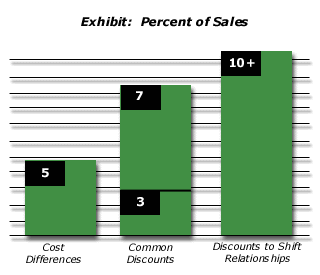THE REAL REASON MARKET SHARE MATTERS
by Donald V. Potter
The fact that market share counts is hardly a revolutionary idea. In fact, it came close to becoming conventional wisdom 15 to 20 years ago, when many began discussing the value of the “learning curve.”
Change the underlying rationale of that conventional wisdom and you see that market share does count – but for much more than the reasons thought before.
Customers Never Leave for Equal Value
“Customers have strong incentive to stay with their current, known suppliers.”
The traditional reason for wanting market share is to lower cost by moving down the learning curve.
Greater volume leads to greater cumulative experience, which should reduce unit cost. This idea, which won wide acceptance in the 1970s, has fallen somewhat out of favor. But in most industries, the learning curve is valid. Greater volume does lead to lower cost to serve customers.
There is an even more significant value in market share. Market share means that you “own” a certain number of customer relationships – you are established with those customers and are meeting their needs. And, all things being equal, customers have strong incentive to stay with their current, known suppliers. There is risk in movement – risk of the unknown, of internal disruption. Inertia always favors the current supplier.
The key phrase is “all things being equal”. Customers virtually never leave their current supplier for another that offers essentially the same deal. They leave only when another supplier offers better value through either higher performance (features, reliability, convenience) or lower price. The “new deal” has to be sufficiently better to overcome inertia.
Satisfied Customer is Costly Barrier
A competitor who wants to take away a customer you “own” will have to invest in offering a significantly better deal. The investment cost of enticing your satisfied customer more than offsets any functional cost advantage a competitor might have in serving that customer.

Let’s be concrete: The Exhibit illustrates a mature market. In mature markets, the measurable, functional cost differences between the strongest and weakest competitors, as a percentage of sales, is seldom as much as 10%. Most often, the cost differences among peer competitors is equivalent to less than 5% of sales. Customers can readily find discounts in the range of 3-7% off standard pricing. However, little net share changes on these discounts. Rather, the cost of breaking into an established relationship and taking away the customer is often 10% or more. Even if a lower cost competitor sought to take customers you “own”, he would have to invest his apparent cost advantage (~5%) plus an additional increment (~5%) to move the customer relationship.
Why Market Share Matters
Market share is a measure of customers “owned”. As the numbers above show, the existing supplier is the low cost competitor for his customers because the cost to move a customer relationship is so high. Ownership of the customer relationship is worth more than any other competitor’s apparent “cost advantage”. Ownership is the low cost position.
The lowest overall cost position, of course, is ownership of the greatest number of customers. That competitor also benefits from the learning curve and traditional economics of scale. Market share matters, then, because it leads to the lowest cost position in the industry.
Implications for Hostile Markets
Before giving up a customer, a company would want to consider:
- Might it want the customer back within the next five years?
- Will the company’s contribution dollar increase?
- Will the competitor who follows in the customer relationship be worse off?
(Note: This Perspective was written in the context of the economy in 1991. While some of the companies may have changed their policies or indeed no longer exist, the patterns they exhibit still hold today.)
| Recommended Reading |
| For a greater overall perspective on this subject, we recommend the following related items:
Analyses:
Symptoms and Implications: Symptoms developing in the market that would suggest the need for this analysis.
*** |
